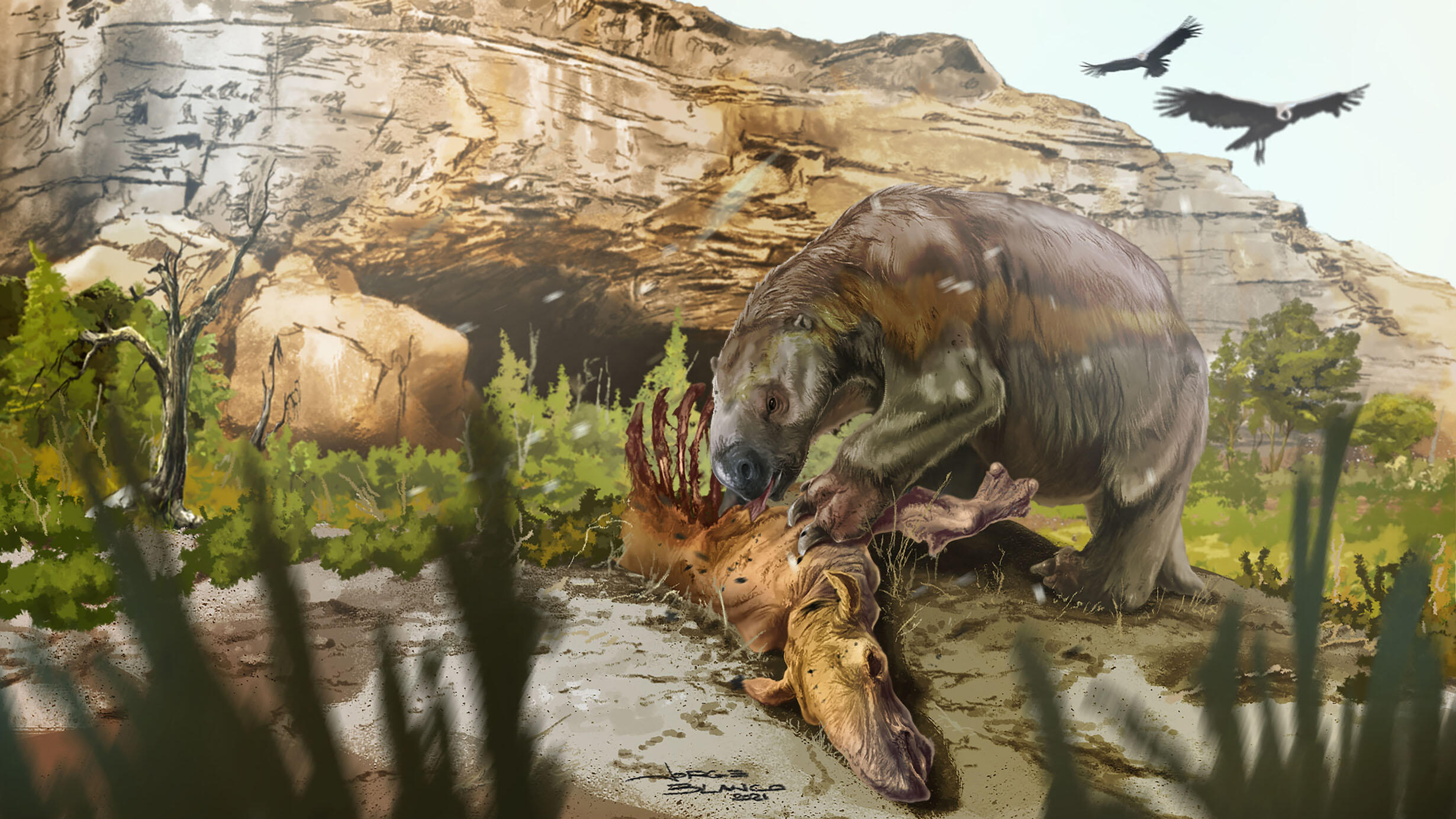 Reconstruction of the South American giant ground sloth Mylodon darwinii feeding on the carcass of the hoofed native herbivore Macrauchenia. These extinct mammals roamed the Pleistocene landscape of Patagonia and other parts of high and mid-latitude South America, like this reconstructed scene from about 12,000 years ago in front of the famous Mylodon Cave (Cueva del Milodón) in southern Chile.
Reconstruction of the South American giant ground sloth Mylodon darwinii feeding on the carcass of the hoofed native herbivore Macrauchenia. These extinct mammals roamed the Pleistocene landscape of Patagonia and other parts of high and mid-latitude South America, like this reconstructed scene from about 12,000 years ago in front of the famous Mylodon Cave (Cueva del Milodón) in southern Chile.Artistic reconstruction: Jorge Blanco
Today, all six living sloth species are relatively small plant-eating tree-dwellers. But a new study suggests that Mylodon—a giant ground sloth that lived in South America until about 10,000 to 12,000 years ago—was not a strict vegetarian, at times eating meat or other animal protein in addition to plants.
“We now have strong evidence contradicting the long-standing presumption that all sloths were obligate herbivores,” said Julia Tejada, a Museum research associate and postdoctoral researcher at the University of Montpellier, France, who is lead author on the study, published today in the journal Scientific Reports. Tejada began this study as a Ph.D. student in the Museum’s Richard Gilder Graduate School collaborative program with Columbia University.
Hundreds of fossil sloth species, some as large as an elephant, once roamed ancient landscapes from Alaska to the southern tip of South America. Mylodon darwinii, also known as “Darwin’s ground sloth,” is thought to have weighed between 2,200 and 4,400 pounds and was nearly 10 feet long.
Based on dental characteristics, jaw biomechanics, preserved excrement from some very recent fossil species, and the fact that all living sloths exclusively eat plants, Mylodon and its extinct relatives have long been thought to be herbivores as well. But these factors could not directly reveal whether an animal might have ingested food that requires little or no preparation and is completely digested, as happens in carcass scavenging or some other kinds of meat-eating.
To get a more complete picture, researchers analyzed the amount of nitrogen in hair samples from living and extinct species of sloths and anteaters—close relatives of sloths. Nitrogen is found in different proportions in plants and animals and is also preserved in fossils, allowing paleontologists to determine whether an animal was a plant-eating herbivore, mixed-feeding omnivore, meat-eating carnivore, or specialized marine animal consumer.
© Julia Tejada
The results clearly flagged Mylodon as an omnivore, while the other extinct sloth in the study, the North American ground sloth Nothrotheriops shastensis, was determined to be an exclusive herbivore.
Prior research speculated that there were more herbivores than could be supported by the available plants in ancient ecosystems of South America, suggesting that some of those herbivores may have been finding other sources of food. This new study provides compelling evidence to support that idea.
“These results, providing the first direct evidence of omnivory in an ancient sloth species, demands reevaluation of the entire ecological structure of ancient mammalian communities in South America, as sloths represented a major component of these ecosystems across the past 34 million years,” Tejada said.